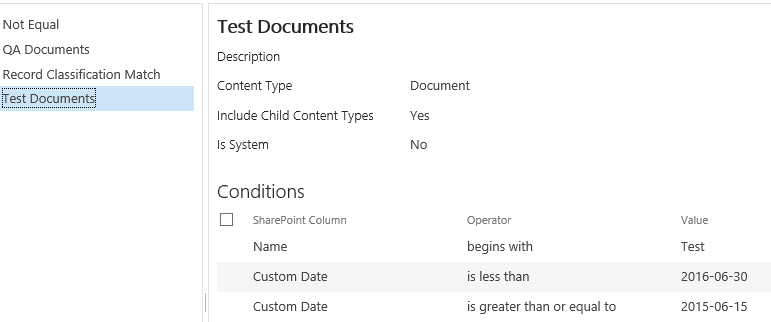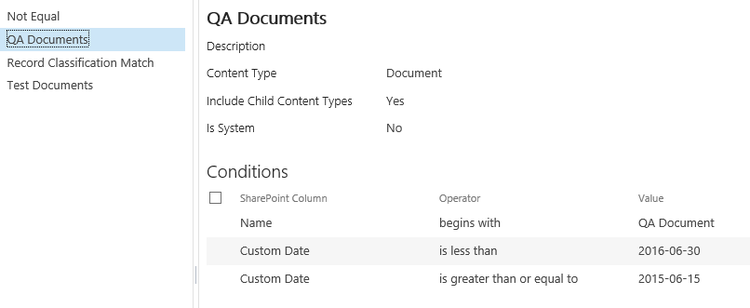
Identifying SharePoint content throughout your ECM deployment is difficult and cumbersome with the out-of-the-box tools. SharePoint Enterprise Search, when using the advanced features, can allow a user to build a query to match content using some metadata fields (SharePoint columns and values). How can this user action on items matched by a query? Can retention be applied to all these items? Unfortunately, that’s currently not possible. Collabware CLM brings the ability to define and save a ‘rule’ (i.e. query) using our custom built interface. Collabware CLM uses your rules to match content as it is created, modified, or discovered. Next, it will apply a Collabware CLM workflow giving the user greater control and improved lifecycle management in their ECM deployment. While Collabware CLM content rules have existed since the first release of the software, Collabware CLM 2016 offers new and improved functionality. Here are a few highlights:
In Collabware CLM versions prior to Collabware CLM 2016, it was impossible to create a content rule with optional matching conditions; all conditions must be satisfied for a successful match. The work around was to create multiple separate rules for each optional condition. Let’s look at an example. Suppose the user wants to create a content rule that matches SharePoint with:
- a Document or inherited content type, and
- has a date field value (ex: Created) on or after June 15, 2015 but before June 30, 2016, as well as having a file name that begins with ‘Test’ or ‘QA Document’
In Collabware CLM versions prior to Collabware CLM 2016, this rule would have to be split into two Content Rules and then used together. The two content rules would look like the following:
Content Rule 1
- a Document or inherited content type, and
- has a date on or after June 15, 2015 but before June 30, 2016, as well as
- having a file name that begins with ‘Test’
 Content Rule
Content Rule
Content Rule 2
- a Document or inherited content type, and
- has a date on or after June 15, 2015 but before June 30, 2016, as well as
- having a file name that begins with ‘QA Document’
 Content Rule
Content Rule
The two content rules “Test Documents” and “QA Documents” would have to be applied to the policies together.
In Collabware CLM 2016, this can be built as a single rule because of the new logical condition grouping and the ‘Any’ or ‘All’ modifiers. In addition, the user can test the content rule against existing SharePoint content by providing the content’s unique identifier. The conditions will become red or green depending the condition passing or failing. Here’s the content rule in Collabware CLM 2016:

 Testing a SharePoint Document
Testing a SharePoint Document
 Execution of the Test
Execution of the Test
In summary, as each version of Collabware CLM is released, new functionality is introduced and existing functionality improved and evolved. Your ECM on SharePoint with Collabware CLM 2016 gives your organization the essential tools to manage the lifecycle your users’ content.
Click here to visit the Collabware CLM page or click the button to download the brochure:





